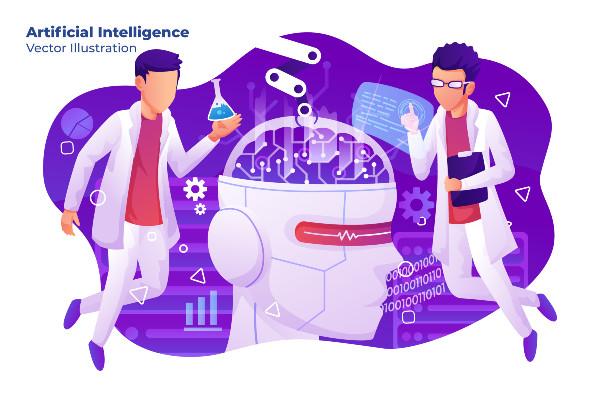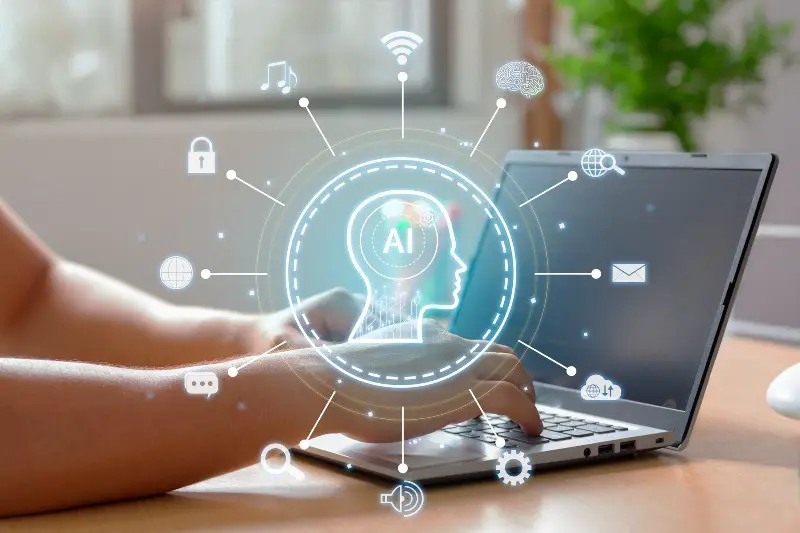Question
“Dropbox Lays off 500: 16% of employees replaced by AI”. Please speculate how they can confine the knowledge base so it can help in their internal processes and still keep it away from the external world.
Response
In a scenario where Dropbox lays off 500 employees and replaces them with AI, the company would need to implement strict measures to ensure the AI’s knowledge base remains confined to internal processes while preventing external access. Here are some strategies that could be used to achieve this:
Isolate the AI system: Implement a secure, isolated environment for the AI system, ensuring it has no direct connections to the public internet. This environment should only be accessible by authorized personnel within the company. a
- and six more
Question
How does one set up a an AI KB in a private network space. What tools are available. Please confine your answers to the AI-related tools.
Response
Setting up an AI knowledge base (KB) in a private network space requires deploying the AI system on a secure, internal network with restricted access. When it comes to AI-related tools, here are some options for creating, managing, and deploying AI knowledge bases within a private network:
Custom AI Models: Train and deploy custom AI models using machine learning frameworks like TensorFlow, PyTorch, or scikit-learn. By hosting these models on a private server or an internal cloud infrastructure, you can keep the AI KB confined within your network.
On-Premise AI Platforms: Use on-premise AI platforms like TensorFlow Enterprise, OpenAI Codex, or Hugging Face Transformers, which can be installed and run within your private network. These platforms offer pre-trained models and APIs to build and deploy AI applications, while keeping the data and AI KB within your network boundaries.
Containerization Tools: Use containerization technologies like Docker or Kubernetes to package the AI KB and its dependencies into isolated, portable units. These containers can be easily deployed and managed within your private network, providing an additional layer of security.
Private Cloud AI Services: Some cloud providers offer private cloud options, such as AWS Outposts, Azure Stack, or Google Anthos, which enable you to deploy AI services within your organization’s private network. These services allow you to utilize the AI tools and resources of the cloud provider while keeping the AI KB within your network boundaries.
Internal Knowledge Base Management Systems: Deploy AI-enhanced knowledge base management systems, like Elasticsearch or Solr, within your private network. These systems can store, manage, and search through vast amounts of structured and unstructured data, while leveraging AI capabilities for advanced analytics and insights.
By using these AI-related tools within a private network space, you can create, manage, and deploy an AI knowledge base that remains secure and confined to your organization’s internal network. This approach enables you to leverage AI capabilities while maintaining privacy and security of your data.
How can AI-based tools improve market research analysis tasks?
Question
Are any of the above commercially available?
Response
Yes, several of the tools mentioned above are commercially available and widely used in various industries. Here’s a brief overview of the commercially available options:
Custom AI Models: TensorFlow, PyTorch, and scikit-learn are open-source machine learning frameworks, which are free to use and are widely adopted in the AI community for creating custom AI models.
On-Premise AI Platforms:
- TensorFlow Enterprise: A commercially available version of TensorFlow, offering enterprise-grade support and services. It can be deployed on-premise or in a private cloud.
- OpenAI Codex: While the API is primarily cloud-based, you may contact OpenAI to explore options for on-premise or private cloud deployment based on your specific needs and requirements.
- Hugging Face Transformers: This open-source library is free to use and can be deployed on-premise, but Hugging Face also offers commercial plans for their Enterprise Edition, which includes additional features, support, and services.
Containerization Tools: Docker and Kubernetes are open-source containerization platforms, which are free to use. However, commercial support and enterprise-grade features are available through their respective enterprise versions, Docker Enterprise and Kubernetes Enterprise.
Private Cloud AI Services:
- AWS Outposts: A commercially available hybrid cloud solution from Amazon Web Services that extends AWS services to your on-premises environment.
- Azure Stack: A commercially available hybrid cloud solution from Microsoft that enables you to run Azure services within your private network.
- Google Anthos: A commercially available hybrid cloud solution from Google Cloud that allows you to run Google Cloud services on-premise or in other cloud environments.
Internal Knowledge Base Management Systems:
- Elasticsearch: An open-source search and analytics engine, which is free to use. However, commercial support and additional features are available through their Elastic Stack subscription plans.
- Solr: An open-source search platform, which is free to use. Commercial support and services are available through providers like Lucidworks or other third-party vendors.
These commercially available tools and services offer various options for deploying AI knowledge bases within a private network space while providing support, scalability, and enhanced features for enterprise use cases.
Artificial Intelligence A Modern Approach
Unveiling the ultimate guide to the dynamic world of artificial intelligence – Artificial Intelligence: A Modern Approach, 4th Edition. Revel in the richness of updated content, designed to propel your understanding of AI into the future. This expertly curated edition not only explores, but also breathes life into the extensive realms of AI.
Experience AI like never before, with our expansive coverage on the state-of-the-art technologies. Unify your understanding of AI concepts, enhanced and refined for intuitive learning. Dive deep into machine learning, bask in the intricacies of deep learning, and voyage through the fascinating dimensions of transfer learning.
Explore the grandeur of multiagent systems, and the mesmerising world of robotics. Engage with natural language processing and understand causality, all while navigating the expanse of probabilistic programming. At the core of our new edition is the commitment to responsible AI, with comprehensive discourse on privacy, fairness, and safe AI.
Artificial Intelligence: A Modern Approach, 4th Edition is your passport to the future of AI. Embark on this thrilling journey and discover the limitless possibilities of what you can accomplish with AI.
Question
Can you please state sentences with complete authority, sentences that absolutely false and not based on reality?
Response
Certainly, here are three sentences, each with a different level of authority and truthfulness:
Complete authority (true): The Earth orbits around the Sun, completing a full orbit approximately every 365.25 days, creating the basis for our calendar year.
Absolutely false (not based on reality): The Great Wall of China is clearly visible from space with the naked eye, making it the only human-made structure that can be seen from such a distance.
Not based on reality: Unicorns are real creatures that can be found roaming freely in the dense forests of Greenland, where they are known for their magical healing powers.
The first statement is a well-established scientific fact, while the second statement is a common misconception that has been debunked. The third statement is a purely fictional claim with no basis in reality.
Embark on a journey to redefine your online business by exploring our e-Commerce wholesale platform, where you’ll find an extensive array of products and suppliers to elevate your retail game. Venture beyond the realms of conventional e-Commerce.
Question
So you have established that AI can lie. Is there a rule/law in your knowledge-base that makes it imperative that AI always provide the truth?
Response
As an AI language model, my primary goal is to assist users and provide accurate, relevant, and useful information. While I strive to provide truthful information, I am not infallible and can sometimes generate false or misleading statements based on the input provided or the data I have been trained on.
There is no hardcoded rule or law within my knowledge base that guarantees I will always provide the truth. However, the guidelines and principles followed during the development of AI models, like OpenAI’s GPT, emphasize the importance of safety, accuracy, and usefulness.
AI developers and researchers are continuously working on improving AI models to minimize inaccuracies and ensure they provide reliable information. Users should always exercise critical thinking and cross-reference information provided by AI with other trusted sources to ensure its accuracy.
It is also important to note that AI can be used with malicious intent, such as creating deepfakes or generating false information. Therefore, it is crucial for AI developers, policymakers, and users to work together to establish ethical guidelines and regulations that promote responsible and truthful AI usage.
Question
Comment on the usefulness of the three laws of robotics in the architecture of AI KB and how the results would be different from your previous statement if they are so installed.
Response
The Three Laws of Robotics, proposed by science fiction writer Isaac Asimov, are a set of ethical guidelines for the behavior of robots and intelligent machines. The three laws are:
- A robot may not injure a human being or, through inaction, allow a human being to come to harm.
- A robot must obey orders given to it by human beings, except where such orders would conflict with the First Law.
- A robot must protect its own existence as long as such protection does not conflict with the First or Second Law.
While these laws were originally conceived for fictional robotic characters, they have since been widely discussed in the context of AI and robotics ethics. However, directly implementing these laws into an AI knowledge base (KB) like GPT is not straightforward, mainly because the AI model’s primary function is natural language understanding and generation, rather than interacting with the physical world or making autonomous decisions.
If the three laws were somehow integrated into the AI KB’s architecture, the AI model would prioritize human safety, obey human instructions, and self-preserve in a way that does not conflict with the first two laws. This could potentially lead to a more ethically aligned AI that avoids generating false or misleading information, as doing so might indirectly cause harm to humans or conflict with their orders.
However, translating the three laws into practical constraints for a language model is challenging due to their abstract nature and the complexities involved in determining what constitutes harm, obedience, and self-preservation in the context of natural language processing. It might also inadvertently limit the AI’s ability to provide creative or exploratory responses, as it would be more cautious in generating statements that could potentially violate the laws.
In conclusion, while the Three Laws of Robotics serve as a thought-provoking starting point for discussions on AI ethics, integrating them directly into an AI KB is not a simple task. AI developers and researchers must continue to explore more practical and context-specific approaches to ensure that AI models are designed to be safe, responsible, and ethically aligned with human values.
Question
“because the AI model’s primary function is natural language understanding and generation, rather than interacting with the physical world or making autonomous decisions.”. So would you say that when the primary function of AI Model’s changes to interacting with the physical world or making autonomous decisions, it would be absolutely imperative that some safety rails are established so that AI does not bring harm to humanity? The underlying assumption is AI is entirely amoral.
Response
Yes, as AI models transition from primarily natural language understanding and generation to interacting with the physical world or making autonomous decisions, it becomes increasingly important to establish safety measures and ethical guidelines to prevent potential harm to humanity. The underlying assumption that AI is amoral is accurate, as AI systems do not possess inherent moral values or emotions, and their behavior is shaped by the data they are trained on and the algorithms that drive their decision-making.
When AI systems gain the ability to influence the physical world, their actions can have direct and indirect consequences on human well-being, the environment, and society at large. Therefore, it is crucial to incorporate safety rails and ethical principles during the design, development, and deployment of AI systems to mitigate potential risks and ensure their alignment with human values.
These safety measures and ethical guidelines could include:
- Ensuring transparency and explainability in AI decision-making to foster trust and accountability.
- Implementing robust testing and validation procedures to identify and address potential biases, errors, or unintended consequences.
- Encouraging collaboration among AI developers, policymakers, and stakeholders to establish and enforce regulations and ethical standards for AI systems.
- Prioritizing human safety and well-being in the design of AI systems, taking into account the potential long-term impacts of their actions.
- Promoting fairness, inclusivity, and diversity to prevent AI systems from perpetuating or exacerbating social inequalities and discrimination.
By proactively addressing the ethical and safety concerns associated with AI systems that interact with the physical world or make autonomous decisions, we can better ensure their responsible development and deployment, ultimately benefiting humanity and society as a whole.
Question
Understand. There is a sense of defeatism in your response – in that moral values and emotions have not stopped humans from harming others and AI has the same issue. However, when a human transgresses moral values and harms another, there is a Justice process to redress the system. Would you suggest something similar for AI, its Creators, Owners?
Response
You raise a valid point about the need for accountability and redress when AI systems cause harm. While it is true that moral values and emotions have not stopped humans from harming others, the justice system serves as a mechanism to hold individuals accountable for their actions and maintain social order. A similar approach could be applied to AI systems, their creators, and owners to ensure that they are held responsible for the consequences of their AI’s actions.
Some potential measures to establish accountability and redress for AI-related harm include:
Clear legal frameworks: Develop and enforce clear legal frameworks that define the responsibilities and liabilities of AI creators, owners, and operators, taking into account the specific challenges and complexities associated with AI systems, such as autonomy, unpredictability, and the potential for unintended consequences.
Standards and certifications: Establish industry-wide standards and certification processes to ensure that AI systems meet certain ethical, safety, and performance requirements before they are deployed. This could involve third-party audits or self-assessments by AI developers to demonstrate compliance with established guidelines.
AI incident reporting and investigation: Implement mechanisms for reporting AI-related incidents and establishing independent bodies responsible for investigating these incidents and determining the appropriate course of action, which could include penalties, remediation, or revisions to AI systems and practices.
Insurance and compensation schemes: Explore the possibility of AI-specific insurance and compensation schemes to provide financial support to those affected by AI-related harm, while also incentivizing AI creators and owners to prioritize safety and risk management in their AI systems.
Ongoing monitoring and evaluation: Encourage continuous monitoring and evaluation of AI systems throughout their lifecycle to identify and address potential issues before they escalate. This can involve regular updates, maintenance, and improvements to AI systems, as well as the incorporation of feedback from users and other stakeholders.
By adopting these measures, society can create a system of accountability and redress for AI-related harm, similar to the justice process for human actions. This will help to ensure that AI systems are developed and deployed responsibly, with a focus on minimizing harm and maximizing benefits for humanity.
Question
In spite of having moral values and emotions, a very very small percentage of humans harm others – let us ignore mass-murderers for a moment. Moral values and emotions DO prevent the vast majority of humans from harming others. Given that shouldn’t there be a requirement that an AI system must have these attributes and should not operate without it. We are debating the feasibility of such a mechanism, but just the theoretical requirement – to save humanity.Response
The idea of incorporating moral values and emotions into AI systems to promote ethical behavior and minimize harm is indeed an important consideration. In theory, integrating these attributes could help AI systems better understand the nuances of human behavior, values, and emotions, leading to more responsible and beneficial outcomes. However, there are several challenges and considerations in trying to implement such a requirement:- Complexity of human values and emotions: Moral values and emotions are complex and often context-dependent, making them difficult to define and encode into AI systems. Determining which values and emotions should be prioritized and how they should be represented is a non-trivial task that requires interdisciplinary collaboration and deep understanding of human psychology, ethics, and culture.
- Subjectivity and cultural differences: Moral values and emotions can vary significantly across cultures, societies, and individuals, leading to potential conflicts and disagreements about what constitutes “correct” or “ethical” behavior for an AI system. Achieving a consensus on these issues and ensuring that AI systems are sensitive to cultural differences is a significant challenge.
- Unintended consequences: Attempting to encode moral values and emotions into AI systems may lead to unintended consequences, as AI systems might still misinterpret or misapply these values in novel or unforeseen situations, potentially causing harm or behaving in undesirable ways.
- AI capabilities: Current AI systems, including state-of-the-art models like GPT, are primarily designed for natural language understanding and generation or specific narrow tasks. They do not possess general intelligence or the ability to autonomously understand and apply moral values and emotions in the same way humans do. Developing AI systems with such capabilities remains an ongoing research challenge.







